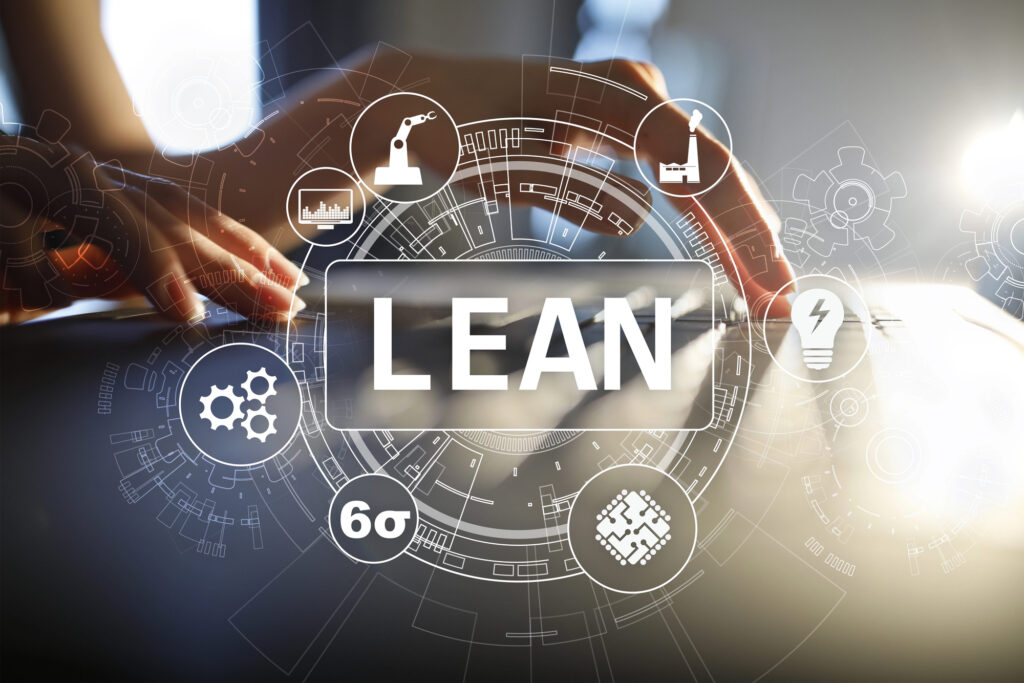Lean principles have been a cornerstone of operational excellence for decades, focusing on maximizing value and minimizing waste. However, the rapid evolution of technology and shifting workforce dynamics necessitate a fresh look at these principles. In today’s business environment, staying competitive means not only adhering to these time-tested principles but also embracing innovative approaches and tools that can enhance their effectiveness.
The modern business landscape is characterized by the integration of advanced technologies such as artificial intelligence (AI), the Internet of Things (IoT), big data, and digital twins. These technologies offer unprecedented opportunities to gain insights, optimize processes, and create value. Additionally, the workforce is evolving, with newer generations bringing different expectations and values to the workplace. This necessitates a more agile, responsive, and employee-centric approach to implementing Lean principles.
Modernizing Lean principles involves not just adopting new technologies but also reshaping mindsets and organizational cultures to embrace continuous change and improvement. By integrating these modern approaches, businesses can remain competitive and agile in an ever-evolving market landscape.
In this article, we will explore how each of the five Lean principles—Value, Value Stream, Flow, Pull, and Perfection—can be modernized to keep up with current trends and technologies. We will provide practical examples of how companies can implement these modern approaches to drive innovation, efficiency, and customer satisfaction.
Embracing Customer-Centric Innovation to Define Value
The concept of “value” is fundamental to Lean principles, where it is traditionally defined from the customer’s perspective. This involves understanding what the customer values and ensuring that every process, product, or service delivered meets these expectations. However, in today’s business environment, simply meeting customer expectations is no longer sufficient. The modern approach to defining value necessitates a deeper, more nuanced understanding of customer needs, preferences, and behaviors, made possible through the integration of advanced technologies such as big data analytics and AI.
In the past, businesses relied on customer surveys, feedback forms, and market research to gauge what their customers wanted. While these methods provided valuable insights, they were often limited in scope and depth. The advent of big data and AI has revolutionized this process by enabling companies to analyze vast amounts of data from various sources, including social media, purchase history, browsing behavior, and even real-time interactions. This data-driven approach allows businesses to move beyond reactive strategies and develop proactive, customer-centric innovations that not only meet but exceed customer expectations.
One of the most powerful applications of this modern approach is in the realm of personalized customer experiences. Personalization is no longer just a buzzword; it has become a critical component of customer-centric innovation. For example, in the e-commerce sector, companies are leveraging AI-driven algorithms to analyze individual customer behavior and preferences. This enables them to tailor the shopping experience for each customer uniquely. Instead of offering a one-size-fits-all solution, businesses can now present personalized product recommendations, customized marketing messages, and even individualized pricing strategies. This level of personalization not only enhances customer satisfaction but also drives loyalty and increases sales.
A case study that illustrates the power of customer-centric innovation is that of Amazon, the global e-commerce giant. Amazon has long been a pioneer in using data and AI to create value for its customers. The company’s recommendation engine, powered by AI, analyzes millions of customer interactions daily to suggest products that each individual customer is most likely to be interested in. This has significantly contributed to Amazon’s success, with personalized recommendations accounting for a substantial portion of the company’s sales.
However, Amazon’s commitment to customer-centric innovation goes beyond recommendations. The company uses AI to optimize every aspect of the customer experience, from search results to delivery times. For instance, Amazon’s predictive analytics model can forecast demand for specific products in different regions, enabling the company to stock warehouses accordingly and reduce delivery times. This not only meets customer expectations for fast and reliable service but also anticipates their needs, ensuring that the right products are available when customers want them.
For businesses looking to implement a similar customer-centric approach, several practical tips can help guide the process. First, it is crucial to invest in data analytics and AI technologies. Without the ability to collect, process, and analyze large datasets, companies will struggle to gain the insights needed to innovate effectively. Second, businesses should focus on creating a seamless and personalized customer journey. This involves not only tailoring marketing messages but also optimizing every touchpoint, from website navigation to post-purchase support, to align with individual customer preferences.
Moreover, it is important to cultivate a culture of continuous improvement. Customer needs and preferences are constantly changing, and businesses must be agile enough to adapt to these changes. This requires a mindset that embraces ongoing learning, experimentation, and refinement of processes. Regularly gathering customer feedback, analyzing new data, and iterating on existing strategies will ensure that the business remains aligned with the evolving definition of value.
Finally, cross-functional collaboration is essential for successful customer-centric innovation. Different departments, such as marketing, product development, and customer service, should work together to share insights and align their efforts toward enhancing the customer experience. This integrated approach allows the entire organization to move in sync, ensuring that customer value is consistently delivered across all touchpoints.
Leveraging Digital Twin Technology and Real-Time Analytics for Value Stream Optimization
In the traditional Lean framework, mapping the value stream is a critical step in identifying and eliminating waste. The value stream encompasses all the activities, both value-adding and non-value-adding, involved in delivering a product or service to the customer. By meticulously analyzing these activities, organizations can streamline their processes, reduce inefficiencies, and enhance overall productivity. However, as industries become increasingly complex and technology-driven, traditional methods of value stream mapping can fall short in capturing the dynamic nature of modern business operations. This is where the integration of digital twin technology and real-time analytics offers a transformative approach to value stream optimization.
A digital twin is a virtual replica of a physical system, process, or product. This technology enables businesses to create accurate, real-time simulations of their operations, providing a comprehensive view of how different components within the value stream interact. By leveraging digital twins, companies can experiment with various scenarios, test potential changes, and predict outcomes without disrupting the actual physical environment. This ability to simulate and model processes digitally is invaluable for identifying inefficiencies, bottlenecks, and areas for improvement in a highly controlled and risk-free manner.
The incorporation of IoT devices further enhances the capabilities of digital twin technology. IoT devices collect real-time data from physical assets and processes, feeding this information into the digital twin to ensure that the virtual model accurately reflects the current state of the system. This continuous flow of data allows businesses to monitor their value streams in real-time, making it possible to detect and respond to issues as they arise. The combination of digital twins and real-time analytics provides a powerful toolset for optimizing operations, reducing waste, and improving overall efficiency.
One practical application of this modern approach can be seen in the manufacturing sector. Traditionally, manufacturers relied on manual inspections and historical data to identify inefficiencies within their production lines. While effective to some extent, these methods often led to delays in detecting problems and implementing corrective measures. With digital twin technology, manufacturers can now create detailed simulations of their entire production process, from raw material input to finished product output. These simulations allow them to explore different process configurations, test new technologies, and predict the impact of changes on overall efficiency before making any physical modifications.
A compelling case study highlighting the benefits of digital twin technology and real-time analytics in value stream optimization is Siemens, a global leader in industrial manufacturing. Siemens has successfully implemented digital twin technology across several of its manufacturing plants to enhance operational efficiency and product quality. By creating digital replicas of their production processes, Siemens engineers can monitor the performance of machinery, analyze production data, and simulate different scenarios to identify the most efficient configurations.
For example, in one of Siemens’ turbine manufacturing facilities, the use of digital twins has enabled the company to simulate the assembly process of turbine blades. The virtual model allows engineers to test various assembly sequences, optimize tooling paths, and predict potential defects. As a result, Siemens has significantly reduced assembly time, minimized waste, and improved the overall quality of its turbine products. Furthermore, the integration of IoT devices with digital twins has provided Siemens with real-time insights into the condition of its machinery, allowing for predictive maintenance and further reducing downtime.
For businesses looking to adopt a similar approach to value stream optimization, several practical steps can be taken. First, it is essential to invest in the right technology infrastructure, including digital twin software, IoT devices, and data analytics platforms. This investment will provide the foundation needed to create accurate simulations and gather real-time data essential for optimizing operations. With the right infrastructure in place, businesses can begin by digitally mapping their existing value streams, creating a baseline model that reflects their current processes. This digital map serves as a crucial tool for visualizing and understanding the interactions and dependencies within the value stream.
Once the digital twin is established, businesses should focus on continuously feeding it with data collected from IoT devices integrated throughout the physical environment. These devices can be attached to key machinery, workstations, and other critical points within the production process to monitor performance, track efficiency, and detect anomalies in real-time. By ensuring that the digital twin is constantly updated with the latest data, companies can maintain an accurate, live model of their operations, enabling them to respond swiftly to any issues that arise.
Moreover, businesses should take advantage of the predictive capabilities of digital twins by using them to run “what-if” scenarios. This means experimenting with different process configurations, exploring the impact of potential changes, and optimizing workflows without the risk of disrupting actual production. For instance, a manufacturer might simulate the impact of introducing a new piece of machinery or altering the production sequence within the digital twin before making any physical changes. By analyzing the outcomes of these simulations, businesses can make informed decisions that enhance efficiency and reduce waste, all while minimizing the risks associated with trial-and-error in the physical world.
In addition to optimizing processes, digital twins can also play a crucial role in predictive maintenance. By monitoring the real-time performance of equipment, businesses can predict when machinery is likely to fail or require maintenance, allowing them to schedule repairs during planned downtimes rather than experiencing unexpected breakdowns. This proactive approach to maintenance not only extends the life of equipment but also ensures that production remains smooth and uninterrupted.
As demonstrated by Siemens, the implementation of digital twin technology combined with real-time analytics can lead to significant improvements in operational efficiency and product quality. For businesses aiming to stay competitive, adopting such advanced technologies is becoming increasingly necessary. The ability to continuously monitor, simulate, and optimize value streams in real time provides a clear strategic advantage, enabling organizations to operate more efficiently, reduce waste, and respond swiftly to changes in demand or market conditions.
The Role of Agile and Scalable Solutions to Modernize Flow
With Lean, ensuring a smooth and uninterrupted flow of work is fundamental. This principle, central to Lean thinking, involves creating processes that minimize interruptions, reduce delays, and maintain a steady rhythm of production or service delivery. However, traditional methods for ensuring flow may not be sufficient to address the complexities and dynamics of modern operations. To stay competitive, organizations must modernize their approach to flow by adopting agile methodologies and leveraging scalable, cloud-based solutions.
Agile methodologies, originally developed for software development, have proven to be highly effective in enhancing operational flexibility and responsiveness. The essence of agility lies in its iterative approach, allowing teams to adapt quickly to changes and continuously improve processes based on real-time feedback. By applying agile principles to broader operational contexts, organizations can foster a more adaptive and resilient workflow. This approach emphasizes collaboration, incremental progress, and the ability to pivot in response to shifting demands or unforeseen challenges.
Alongside agile practices, scalable cloud-based solutions play a critical role in modernizing flow. These solutions offer the flexibility to manage fluctuating demand without disrupting operations. Cloud-based Enterprise Resource Planning (ERP) systems, for instance, provide a dynamic platform for adjusting production schedules and resource allocation based on real-time demand forecasts. This capability is particularly valuable in environments characterized by variable demand, where traditional, static systems may struggle to keep pace with changing conditions.
One exemplary case study of these modern approaches in action is the experience of Unilever, a leading global consumer goods company. Unilever has successfully leveraged agile methodologies and cloud-based ERP systems to enhance its operational flow and responsiveness.
Unilever’s commitment to agility is reflected in its efforts to streamline and accelerate its supply chain processes. The company has adopted agile practices to improve collaboration between its various departments and external partners. This approach allows Unilever to quickly adapt to changes in consumer preferences, market trends, and supply chain disruptions. For example, during the COVID-19 pandemic, Unilever implemented agile practices to rapidly adjust its production and distribution strategies in response to shifts in demand for essential products like hand sanitizers and cleaning supplies.
In tandem with its agile practices, Unilever has utilized scalable cloud-based ERP systems to manage its global operations efficiently. These systems enable the company to integrate data across its supply chain, monitor real-time demand, and dynamically adjust production schedules. This integration is crucial for maintaining a smooth flow of products from manufacturing to distribution, ensuring that the right products are available at the right time to meet consumer needs.
The impact of these modern approaches on Unilever’s operational performance has been significant. The company’s ability to swiftly adapt to changing market conditions and optimize its supply chain processes has led to improved customer satisfaction and operational efficiency. By embracing agility and leveraging cloud-based solutions, Unilever has positioned itself to respond effectively to both predictable and unexpected challenges in the global marketplace.
For businesses looking to adopt similar strategies, several practical steps can be taken to modernize their approach to flow. First, organizations should consider integrating agile methodologies into their operational processes. This involves fostering a culture of continuous improvement, encouraging cross-functional collaboration, and implementing iterative processes that allow for rapid adaptation.
Next, investing in scalable cloud-based solutions is essential for managing demand fluctuations and optimizing operational efficiency. Implementing a cloud-based ERP system can provide the flexibility needed to adjust production schedules, allocate resources dynamically, and maintain a smooth flow of work.
In addition to these strategic investments, businesses should focus on developing a robust data infrastructure to support real-time decision-making. By leveraging data analytics and real-time insights, organizations can better understand demand patterns, identify potential bottlenecks, and make informed decisions that enhance overall operational flow.
Harnessing Demand-Driven Supply Chains for Pull
The principle of “pull” is crucial for Lean operations. It dictates that production should only occur in response to actual customer demand, minimizing overproduction and reducing excess inventory. This principle, which emphasizes producing only what is needed, when it is needed, is fundamental to streamlining operations and enhancing efficiency. However, the traditional implementation of pull systems can be improved with advanced technologies. By developing demand-driven supply chains through predictive analytics and machine learning, businesses can enhance their ability to meet customer demand while optimizing inventory levels and reducing lead times.
The modern approach to the pull principle involves leveraging predictive analytics and machine learning to create more responsive and efficient supply chains. Predictive analytics utilizes historical data and statistical algorithms to forecast future demand. Machine learning, a subset of artificial intelligence, refines these forecasts by continuously learning from new data, adapting its predictions over time. Together, these technologies enable businesses to anticipate customer needs more accurately, ensuring that inventory levels are aligned with actual demand.
Implementing just-in-time (JIT) systems with real-time data further enhances the pull principle. JIT systems focus on minimizing inventory and reducing lead times by synchronizing production schedules with demand signals. By incorporating real-time data into JIT systems, businesses can respond more swiftly to changes in demand, reducing the risk of stockouts or excess inventory. This approach not only improves efficiency but also helps maintain optimal inventory levels, contributing to overall cost savings.
A notable case study that exemplifies the benefits of demand-driven supply chains is Walmart’s use of predictive analytics and machine learning to optimize its inventory management. Walmart, a global retail leader, has successfully integrated these technologies into its supply chain operations to enhance its pull system.
Walmart’s approach to demand-driven supply chains involves analyzing vast amounts of sales data to forecast customer demand with high accuracy. The company uses predictive analytics to anticipate trends and adjust inventory levels accordingly. This capability allows Walmart to ensure that its shelves are stocked just in time to meet customer needs without overstocking. By employing machine learning algorithms, Walmart continuously refines its demand forecasts based on real-time data, improving the accuracy of its predictions and reducing the risk of inventory imbalances.
For example, during seasonal sales periods or promotional events, Walmart’s predictive analytics tools analyze historical sales patterns, current market conditions, and other relevant factors to adjust inventory levels dynamically. This approach helps the company avoid the pitfalls of overstocking or running out of popular items, ensuring that customer demand is met effectively and efficiently.
The integration of real-time data into Walmart’s JIT systems has further optimized its supply chain. The company’s advanced inventory management systems enable real-time tracking of stock levels across its vast network of stores and distribution centers. This capability allows Walmart to make timely adjustments to its inventory and production schedules, minimizing lead times and reducing carrying costs.
Businesses looking to modernize their pull systems can take several practical steps to implement demand-driven supply chains. First, investing in predictive analytics and machine learning technologies is essential for improving demand forecasting and inventory management. These tools can help organizations better understand customer demand patterns and make data-driven decisions.
Second, integrating real-time data into JIT systems is crucial for enhancing responsiveness and reducing lead times. Implementing technologies that provide real-time visibility into inventory levels and demand signals enables businesses to synchronize production and distribution with actual customer needs.
Additionally, developing a robust data infrastructure to support predictive analytics and machine learning is vital. This includes collecting and analyzing data from various sources, such as transactions, market trends, and customer behavior, to generate accurate forecasts and optimize inventory levels.
Incorporating Continuous Learning and Adaptation in the Pursuit of Perfection
In Lean principles, the pursuit of perfection is centered on continuous improvement. This principle emphasizes the relentless pursuit of excellence by constantly refining processes and eliminating waste. While the essence of striving for perfection remains unchanged, modernizing this principle requires fostering a culture of continuous learning and adaptation. This involves leveraging digital tools for knowledge sharing and collaboration, as well as integrating comprehensive feedback loops that capture insights from customers, employees, and data-driven sources.
The modern approach to perfection involves creating an environment where learning and adaptation are integral to daily operations. Digital platforms play a crucial role in this transformation. These platforms facilitate real-time knowledge sharing, allowing employees to contribute ideas and insights on process improvements. By fostering a culture where feedback and suggestions are encouraged and acted upon, organizations can drive continuous improvement and innovation.
A key aspect of modernizing the pursuit of perfection is the implementation of robust feedback loops. These loops integrate various sources of feedback, including customer insights, employee suggestions, and data analytics. By systematically capturing and analyzing feedback, organizations can identify areas for improvement, make informed decisions, and implement changes that drive better performance.
One practical example of this modern approach is the use of digital platforms for idea management and continuous improvement. These platforms enable employees to submit improvement ideas, track their progress, and assess their impact. Management can use these tools to review and prioritize suggestions, fostering a culture of collaboration and engagement.
A compelling case study that illustrates the benefits of continuous learning and adaptation is the experience of General Electric (GE) with its “GE Digital” initiative. GE, a global industrial giant, has successfully embraced a culture of continuous improvement through digital transformation and feedback integration.
GE Digital, a division within GE, focuses on leveraging digital technologies to drive innovation and operational excellence. As part of this initiative, GE implemented a digital platform that enables employees to share ideas, collaborate on projects, and track the impact of improvement initiatives. This platform facilitates real-time communication and collaboration across the organization, allowing employees to contribute their expertise and insights.
For example, GE’s digital platform includes a feature called “Idea Submission,” where employees can propose new ideas for process improvements or product innovations. These ideas are reviewed and evaluated by management, and successful proposals are implemented and monitored for their impact. This approach not only encourages employee engagement but also ensures that valuable insights are harnessed to drive continuous improvement.
The feedback loop within GE Digital also incorporates customer feedback and data-driven insights. GE collects customer feedback through various channels, including surveys and direct interactions, and integrates this information into its digital platform. By analyzing customer feedback and operational data, GE can identify trends, address issues, and make data-informed decisions to enhance its products and services.
The integration of these feedback mechanisms has led to significant improvements in GE’s operations. For example, the digital platform has facilitated faster identification of process inefficiencies, enabling GE to implement changes that improve productivity and reduce waste. Additionally, the continuous learning culture fostered by GE Digital has accelerated innovation, allowing the company to adapt to changing market conditions and customer needs.
For organizations looking to modernize their approach to perfection, several practical steps can be taken. First, investing in digital platforms for knowledge sharing and collaboration is essential. These tools enable employees to contribute ideas, collaborate on improvement projects, and track progress.
Second, implementing comprehensive feedback loops is crucial for integrating insights from various sources. This includes capturing and analyzing customer feedback, employee suggestions, and data-driven insights to drive continuous improvement.
Additionally, fostering a culture of continuous learning and adaptation requires leadership commitment and support. Leaders should encourage open communication, recognize and reward contributions, and ensure that feedback is acted upon to drive meaningful change.
Adopting Modern Lean Principles for Operational Excellence
Lean principles remain a foundational framework for achieving operational excellence. However, the integration of advanced technologies and the evolving expectations of the workforce demand a modernization of these principles to maintain their relevance and effectiveness. By leveraging innovations such as digital twins, real-time analytics, and AI, businesses can enhance their value creation processes, optimize flow, and respond to demand more effectively. The pursuit of perfection, now driven by continuous learning and adaptation, ensures that organizations are not only meeting current standards but are also positioned to lead in an ever-changing marketplace.
Embracing these modern approaches requires a shift in mindset and organizational culture. Companies must foster environments where continuous improvement is ingrained in daily operations, supported by digital tools and robust feedback mechanisms. As illustrated by case studies from industry leaders like Siemens, Walmart, and General Electric, adopting agile methodologies, data-driven decision-making, and collaborative platforms can significantly enhance operational performance. Organizations that adopt these modernized Lean principles will not only streamline their processes but also drive innovation and deliver exceptional value, securing their competitive advantage in the future.
Author: Thomas Beil
Publication Date: August 23, 2024
© Copyright 2024 Perfect Planner LLC. All rights reserved.






